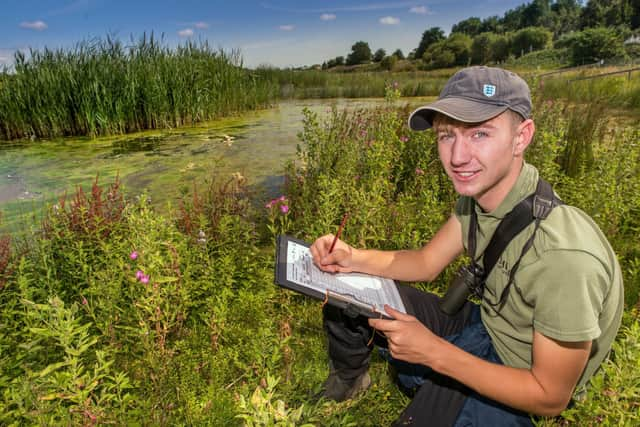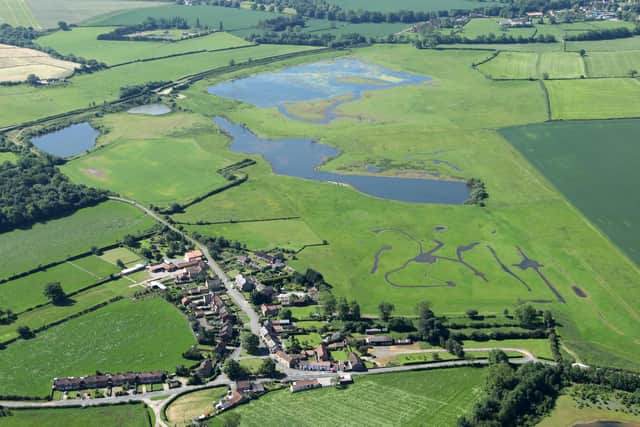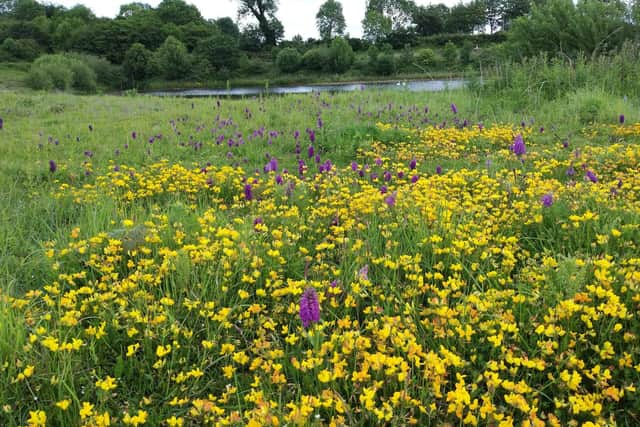Nosterfield Nature Reserve and the trailblazing nature mission
For Simon Warwick, it all began growing up with a garden and river on his doorstep, beginning a life-long love affair with nature.
He grew up in Yorkshire before moving to South Africa and then returning to the region, where he met his wife, Jill.
Advertisement
Hide AdAdvertisement
Hide AdThey both enjoyed bird-watching together at gravel pits, including at Nosterfield, near Ripon, which had a neighbouring gravel quarry.


“I could see there was very active mineral extracting going on and they were exposing the water table, and that was drawing birds in. Even then, I was thinking to myself, gosh, just imagine if you could guide the mineral industry to maximise biodiversity, so you could actually create and design the habitat. That’s how everything kicked off.”
However, none of the established conservation charities were interested in taking Nosterfield on. So instead Simon co-founded the Lower Ure Conservation Trust in 1997.
Today, the 250-acre Nosterfield Nature Reserve has an enviable reputation for its conservation work, and is widely regarded as one of the best examples of wetland grassland in the North. It provides habitat for over 230 species of birds.


Advertisement
Hide AdAdvertisement
Hide AdTheir work has attracted attention from conservation experts. “Chris Packham visited three years ago and we did a bio blitz, and because we have such an amazing range of knowledgeable naturalists we managed to knock up over 1,100 species in a day, which is amazing when you think about it,” says Simon.
What’s remarkable is it’s all driven by the varied talents of its local volunteers. More than 90 per cent of wetland habitats in the region have been lost, and the volunteers at Nosterfield are rescuing them.
Married couple, Pan and Laurie Reed are both 69. The pair, who live in Boroughbridge, were botanical research scientists before running a wholesale nursery, growing herbs and wildflowers for 28 years near Wetherby. They began volunteering at Nosterfield after retiring a decade ago.
They are growing from seed tens of thousands of wetland plants – using surviving fragments of ancient wetland – to recreate habitat from centuries ago.


Advertisement
Hide AdAdvertisement
Hide AdThe ultimate ambition is to attract cranes back to the region, after a 400-year absence.
“That would be a true indicator of success,” Laurie says. “But it all starts with getting the habitat established – working from the plants, bugs, insects and smaller things to create a habitat that will then bring in those bigger organisms, like birds, otters, and you never know, one day, beavers.”
His wife Pan explained how they collected plant material from the tiny fragments of wetlands that survive in the Ure Valley. “Being researchers helped, as we have a more experimental approach to doing things.”
They first began experimental planting in 2018, and the area has grown bigger and bigger.
Advertisement
Hide AdAdvertisement
Hide AdNosterfield is a shining example of how local communities can make a difference. It also shows the difference nature can have on humans.
“This project is something very tangible,” ecologist Martin Hammond says. “People can see the fruits of their labour, literally, with the habitat taking shape. People can see the results. So, it’s quite unusual to have volunteers involved in the entire cycle of something like this.”
The charity received £132,000 from the government’s Green Recovery Challenge Fund, which secured the role of Emma Higgs, a Project Officer who facilitates the volunteers.
And what is Nosterfield’s message to the rest of the world?
“Don’t give up,” Pan says. “We’re trailblazing in Yorkshire with wetland plants, and we’re hoping to create a blueprint that can be copied. But other people will be working in other areas. We can all work towards the same end – the preservation of our planet.”
Young volunteers
Advertisement
Hide AdAdvertisement
Hide AdOne of Nosterfield’s most enthusiastic volunteers is just 16 years old. Joe Fryer, from Ripon, began volunteering in September last year, but has spent most of his life at the reserve bird-watching with his granddad.
“Grandad works in a food factory, but it was always his pastime to go out and bird watch. It really bonded us. I still go out most weekends with him,” Joe says.
Joe is studying animal management and wildlife at Askham Bryan College and says volunteering is important. “Even if it’s a one-day commitment, you can do something that – in the long run – helps.”
Historic site
Nosterfield is close to the ancient monument complex that includes the Thornborough Henges.
Advertisement
Hide AdAdvertisement
Hide AdThe latter, which has been referred to as ‘‘The Stonehenge of the North’’, dates back more than 5,000 years from the Neolithic period and is situated on the northern bank of the River Ure.
Archaeological work at Nosterfield identified pollen from peat samples there to inform the team on the plants that grew thousands of years ago, helping build an accurate picture of the habitats in a post-glacial landscape.
The ecologist at the reserve, Martin Hammond, explains: “We’ve done a lot of research on the landscape and what it meant to local people historically.
“There’s a particularly rich archive of botanical records going back to the 1680s, so we have a very detailed understanding of how that’s changed and which species have disappeared, and why.”
Advertisement
Hide AdAdvertisement
Hide AdMartin says they are introducing plants like Great Fen Sedge. “There are just five sites left of it in Yorkshire. Laurie and Pan cracked how to germinate it, which is very difficult, and now produce thousands of them. We’ve gone out and planted them and they are romping away. It’s very exciting to be able to recreate this ancient habitat.”
Simon elaborates: “Mesolithic people came hunting here because there was a big lake at Nosterfield at the time. It would have been full of red deer, elk, and wild cattle. We are able to recapture a little bit of that history.
“What I really want to do is raise the profile of the whole valley, and retell some of that incredible story of Mesolithic man right through to the Romans – there’s an incredible story to tell, through biodiversity.”
Comment Guidelines
National World encourages reader discussion on our stories. User feedback, insights and back-and-forth exchanges add a rich layer of context to reporting. Please review our Community Guidelines before commenting.
